One of the difficulties in introducing British Israel teaching to
newcomers is to answer the question, "How did the Israelites get
from Palestine to Britain?" - followed by, "What historical
proof is there?" We are usually told, that if our contention is
correct then, surely professional archaeologists and historians would
have discovered and published these things.
We must admit that there are an increasing number of books on
archaeology and ancient history available these days. Few if any, make a
connection between peoples living in Palestine in Biblical times and
peoples living in the British Isles, either before or after the days of
Jesus.
Two very important points must be made before we can start our
investigation. Firstly, we must bear in mind that it is the will of
Almighty God that the ten-tribed House of Israel should be
"lost", and should lose their identity until such times as He
would reveal their whereabouts. Secondly, we can say that many learned
scholars over the last 150 years HAVE researched these things and
published many books giving their findings and conclusions - that the
"Ten Lost Tribes" now dwell in North West Europe, especially
the British Isles. It is to be regretted that some early writers on the
"Identity" did rather let their imaginations run away with
them - allowing sceptical scholars and critics to dismiss the subject on
the grounds that it has no firm foundation in historical fact.
Nevertheless, there is a great deal of collated evidence on this subject
in British Israel literature such as "The Bible Research
Handbook".
However, archaeology and history are on-going disciplines and new
insights are being discovered, as witness the increasing number of new
books on these subjects. Not that any of these books support our
teaching, they do not, except unwittingly! It is left to Identity
believers themselves to read the new material and search out any new
evidence there may be.
This article is an attempt to present the most up to date evidence on
the question posed above - "How did the Israelites get from
Palestine to Britain?"
We start, of course, with the Bible, and the most important
historical fact is that in 880 BC the Kingdom of David and Solomon was
divided into two separate kingdoms (Fig. 1). This fact must be borne in
mind because the histories of these two kingdoms are quite separate,
both in the Bible and subsequent history. Any attempt to make sense of
the Bible or secular historical records without this prime fact will be
doomed to failure.
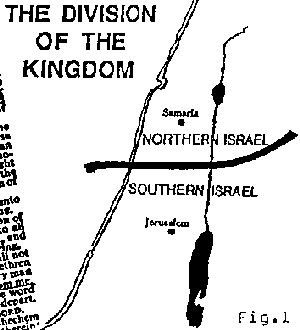
Figure 1 Israel, Division of the Kingdom
The two kingdoms existed side by side for c200 years. The
descendants of David continued to reign over the Southern two-tribed
Kingdom of Judah with its capital at Jerusalem, while the Northern
ten-tribed Kingdom of Israel with a capital at Samaria, had various
ruling dynasties.
During this 200-year period, the history of these two kingdoms was
recorded in the Bible. Neither kingdom remained faithful to the Lord
their God, and in spite of repeated warnings from the prophets, the
people, and many of their rulers, became increasingly pagan. The
inevitable happened and the preordained sentence of punishment (Lev.26,
v18) fell on the Northern Kingdom. This "seven times"
punishment took the form of banishment from the Promised Land and
the instrument God used was the mighty empire of Assyria (Fig. 2). Three
Assyrian kings were involved in the subjugation and deportation of
Israel, Tiglath-Pilesar, Shalmaneser and Sargon II. Not only are these
deportations detailed in the Bible but the Assyrian records confirm the
Biblical account.
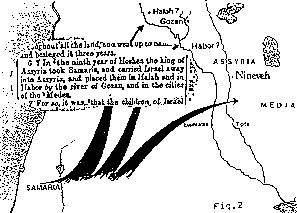
Figure 2 Israel Carried Away |

Black Obelisk of Shalmaneser |
For example, there is the Black obelisk of Shalmaneser in the British
Museum which reports the "Tribute of Iaua of Bit Humri", that
is the "Tribute of Jehu of the House of Omri". Omri was one of
the kings of Northern Israel and he is shown on this Assyrian monument
kneeling in submission before the Assyrian king. It is by studying
monuments like these and the many thousands of Assyrian letters and
documents in the British Museum that British Israel scholars have solved
the mystery of exactly what happened to deported Israel.
As we have seen from Shalmaneser's Obelisk, the Assyrians called the
Israelites "Humri" or "Khumri" - their way of saying
"Omri". However this name soon disappears from the Assyrian
records. Within 15 years of the deportations in precisely the identical
area into which Israel had been placed, we have the first appearance of
a people called "Gimira" in the Assyrian records. This name
"Gamira" or "Gamir" is evidently a corruption of the
Assyrian "Khumri", formed by reversing some of the letters, in
this case IR for RI. Such inversions were common in the writings of the
time.
Omri in Hebrew characters would start with the letter AYIN which in
old Hebrew was pronounced GHAYIN with a soft sound as in the Scottish
"loch". So "Omri" would have been pronounced GHOMRI
by the Israelites themselves and written by the Assyrians KHUMRI and
then later inverted to KHUMIR or GAMIR.
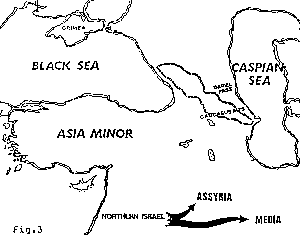
Figure 3 Israel & Asia Minor
In the year 707 BC an Assyrian frontier port reported that armed
forces of Uratu were invading the area into which Israel had been placed
15 years earlier. The attack was halted by the eastern group of GIMIRA
who put up a strong resistance. So here we have Israel - in Media - very
much alive and well. The report states, "When the king of Uratu came
into the land of Gamir (or Gamira) his army was routed."
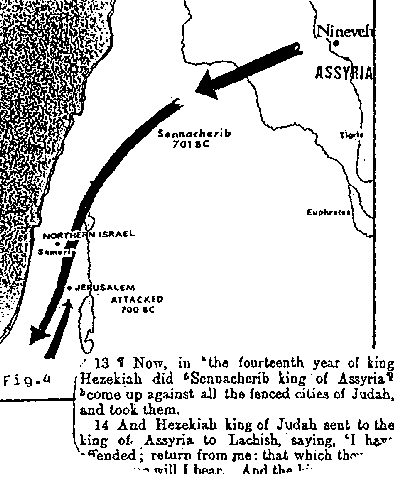
Figure 4 Jerusalem Attacked 700 BC
Back in Palestine, Israel's sorry tale of mass deportations was not
yet at an end. In 700 BC the Assyrian king Sennacherib struck northward
towards Jerusalem on his way back from an invasion of Egypt (Fig. 4). In
2 Kings 14 v13 we read, "Now in the 14th year of Hezikiah did
Sennacherib, king of Assyria come up against the fenced cities of Judah
and took them." This event is recorded also by the Assyrian king on
wall plaques in his palace and on a Prism which is now in the British
Museum (Fig. 5). Note that the Prism details the number of captives on
this occasion - 200,150 men women and children - deported to join the
Israelites already in Media.
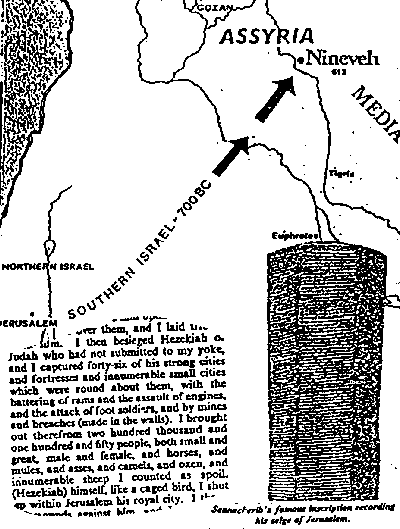
Figure 5 Prism
Still remaining in Palestine were the rest of the tribe of Judah, the
tribe of Benjamin and most of the tribe of Levi. They had Jerusalem for
their capital and a descendant of David as their king. However, neither
the sorry tale of their deported brethren, nor the warnings of the
prophets availed to turn them from their wickedness. In fact, we are
told that their idolatrous behaviour became worse than that of the
Northern Israelites.
About 130 years after the fall of Samaria, punishment fell upon the
Kingdom of Judah when Nebuchadnezzar, King of Babylon attacked
Jerusalem. Finally, Jerusalem was destroyed and most of the people of
Judah were taken captive to Babylon. The Babylonians destroyed Solomon's
Temple and carried all the treasure and artefacts away to their own
land. This "Captivity" lasted for 70 years as prophesied by
Jeremiah (2 Chron. 36). Many of these Judahites settled happily in
Babylon and had no desire to return to a ruined Jerusalem. Others -
patriots - longed for their own land. Then Cyrus, the Persian King who
had conquered Babylon, gave permission for those who wished to return,
to do so.
48,000 Judahites, Benjaminites and Levites returned under Ezra and
Nehemiah whose nominal lists of workers includes none from Northern
Israel. These, who returned from Babylon, became the ancestors of the
Jews of the times of Jesus. We must note that during the 450 years
between the return from Babylon and the times of Jesus, many
non-Israelites especially Edomites, had become Jews by religion (for
example, Herod was an Edomite, called an "Idumean" in the New
Testament).
So the situation is now this, the ten-tribed House of Israel plus
200,000 from the two-tribed House of Judah were deported to Assyria and
seemingly "lost". Part of the House of Judah returned from
their captivity and their descendants, the Jews, continued to live in
Judea until New Testament Times.
One clue to the whereabouts of the "lost" Israelites (from
a secular source) is given by the Jewish general and author Josephus,
who, in his book "Antiquities" (AD.70), said: "There are
but two tribes in Asia and Europe subject to the Romans, while the Ten
Tribes are beyond Euphates and are an immense multitude, not to be
estimated by numbers".
We must imagine these multitudes of Israelite people, displaced
refugees, uprooted from their own land, herded away hundreds of miles
into alien territory. Their surroundings change, they hear different
language, they appear to lose the art of writing, their very way of life
changes and they are called by different names by their captors.
Seemingly the Lord's great plan for His chosen servant Nation has
dissolved into thin air - but let us see what actually did happen.
In the reign of Sargon II, an Assyrian intelligence report told the
King that there were people called GIMIRA (we recognise them as deported
Israelites) located just west of the upper Euphrates, north of the
Taurus mountains. Others were further east in Media (Fig. 6).
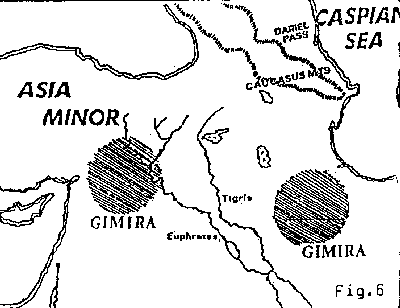
Figure 6 Gimera
In the Apoccrypha (2 Esdras 13) we are told how some of the Ten
Tribes escaped from Assyrian control via the upper Euphrates valleys.
Later they became notorious in Asia Minor when they overthrew King Midas
of Phrygia (Fig. 7). These were the western group of GIMERA or
CIMMERIANS, called KIMMEROI by the Greeks - another version of the
Assyrian KHUMRI.
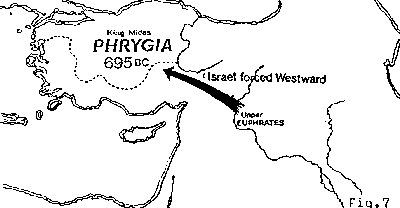
Figure 7 Israel Forced West
In the second year of Esar Haddon of Assyria (679 BC) another group
of GIMERA were defeated by his forces and were pursued westward into
Asia Minor (Fig. 8).
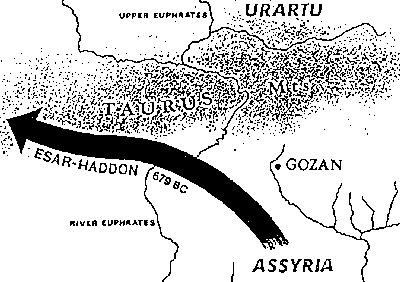
Figure 8 Gimera Pursued Westward
Some of them settled in the Sinope area on the Black Sea, some
migrated across the Sea to settle in the Crimea and in Arsereth (see 2
Esdras 13). On one of their forays they captured the city of Sardis
(Fig. 9). Finally about 600 BC, King Alyattes of Lydia drove them out of
Asia Minor altogether. Their movements were westward - ever westward.
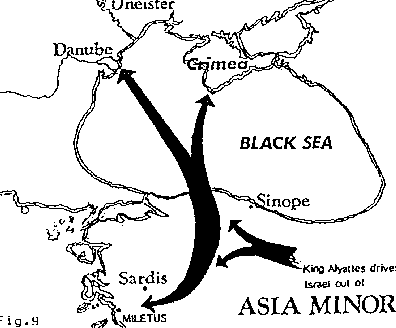
Figure 9 Israel Driven Out of Asia Minor
Most of the western CIMMERIAN group migrated up the Danube valley and
settled as CELTS in central Europe between 500 BC and 100 BC (Fig. 10).
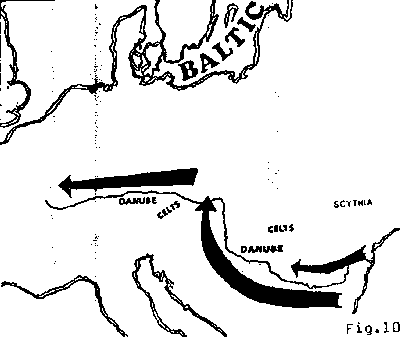
Figure 10 Cimmerians Settled as Celts
Others moved north and west into sparcely inhabited regions of the
Baltic, where they were given yet another name by the Romans - CIMBRI, a
name probably derived from CIMMERIANS. These people were the ancestors
of the Picts and Jutes (Fig. 11).
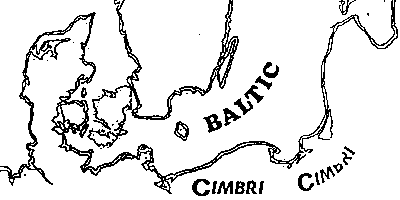
Figure 11 Ancestors of Picts and Jutes
Small numbers of Israelites followed Phoenician trade routes from the
port of Miletus or the South West coast of Asia Minor (Fig. 12). Some
settled for a time in Spain then moved on to Ireland.
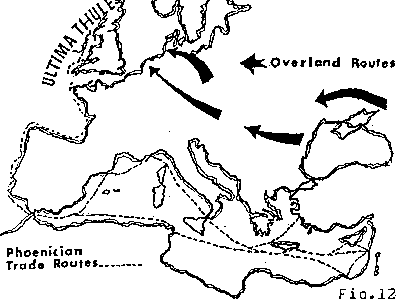
Figure 12 Some Israelites Followed Phoenician
Trade Routes
Now we have seen that most of the Western group of the
"lost" Israelites were forced right through Asia Minor into
Central Europe and finally to the shores of the North Sea; but the
Eastern group were still dominated by Assyrian powers and their
successors, being threatened by Babylonians and Medes from the south
(Fig. 13).
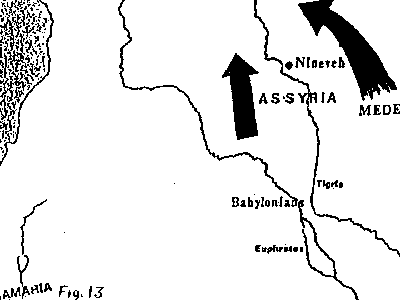
Figure 13 Israelites, Eastern group
This eastern part of Israel although known as GIMIRA was also known
to the Assyrians as ISKUZA, a name derived from the name ISAAC - one of
the names ancient Israel used to describe themselves, "sons of
ISSAC".
In 573 BC, ISKUZA are mentioned for the first time in any historical
document, locating them in Media in the very place where some of Israel
had been put in captivity. Since the GIMIRA and the ISKUZA appear in the
same place at the same time, it is reasonable to infer that they were
one are the same people. And of course the Greeks had a word for these
ISKUZA - they called them SCUTHAE or SCYTHIAN. The Persian name for the
ISKUZA was SAKKA also based on ISAAC wit the emphasis on the last
syllable "ISS-SAAK".
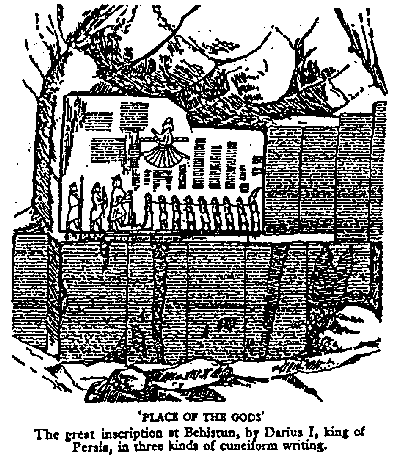
The inscriptions on the great rock carving at Behistan in northern
Iran are repeated in three languages, Old Persian, Susian and
Babylonian. The people who are called "SAKKA" in Persian are
called "GIMIRA" in Babylonian, thus proving the to be one and
the same people.
Root SK derivatives
ISAAC
SAKKA
ISKUZA
SKUTHAE
SCYTHIANS
The Israelites did call themselves the House of Issac or
ISAAKA. The basic root of ISAAK, SAKKA, SKUTHAE, ISKUSA and
SCYTHIAN is SK in each case.
After the fall of the Assyrian capital Nineveh in 612 BC, the main
body of Scythian Israelites came under such pressure from the Medes that
they were forced northwards through the Dariel Pass in the Caucasus
mountains and into the steppe region of southern Russia (Fig. 14).
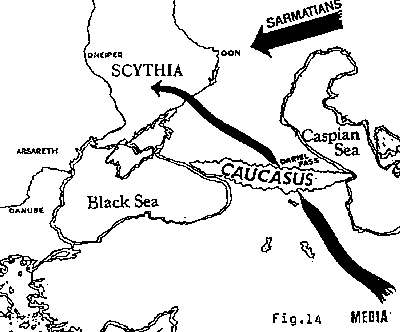
Figure 14 Cimmerian Israel
As wave after wave of these people were forced through the Caucasus,
the leaders in the west crossed the rivers Don and Dniper and came into
contact with CIMMERIAN Israel groups who had earlier moved across the
Black Sea, thus pushing them westward along the valley of the Danube
into Central Europe (Fig. 15).
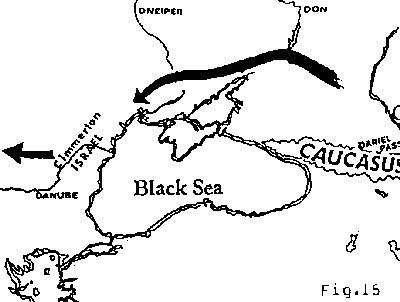
Figure 15 Israelites, Eastern group
Although the Scythians established themselves in the area of southern
Russia from the 6th to the 3rd centuries BC, they found themselves
squeezed between a people advancing from the east - the Sarmatians - and
the CELTS, already occupying Central Europe to the west. Consequently,
they were forced northward towards the North Sea and the Baltic (Fig.
16). This group formed the last of the migrating Israelites to arrive in
these Islands. The Anglo-Saxon group from the area now called Germany
arriving between 400 and 600 AD.
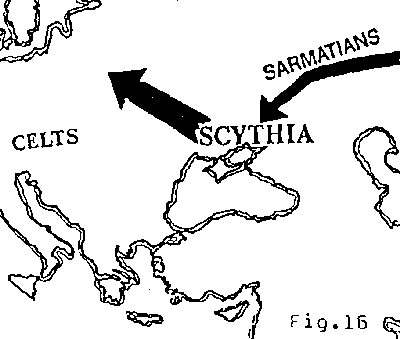
Figure 16 Scythian Israelites Forced
Northward
Others moving northwards through Jutland became known as Danes and
Vikings. Others settled for a time in northern France and were known as
Northmen or Normans. These Normans arrived in the 11th century, the last
large group, finally completing the regathering of what Sir Arthur
Keith, world-famous ethnologist, described as one family - NOT a
racially mixed group.
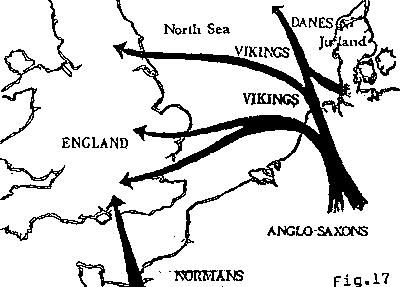
Figure 17 Anglo-Saxons, Danes, Normans &
Vikings
In exile, the Nation of Israel became divided into two main groups,
one in the upper Euphrates area and the other in Media. These two
groups migrated by different routes and at different times. Thus, they
arrived here in comparatively small groups over a long period of time -
finally fusing in to one Nation, which we now call the United Kingdom of
Great Britain and Northern Ireland.